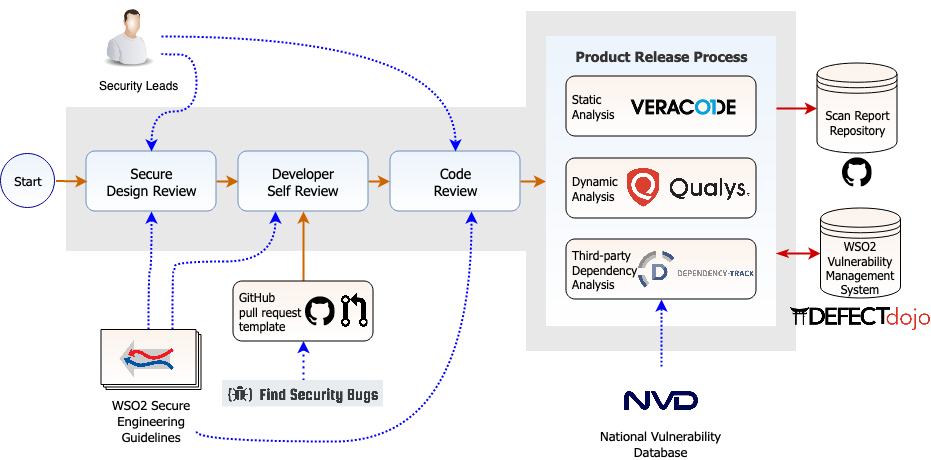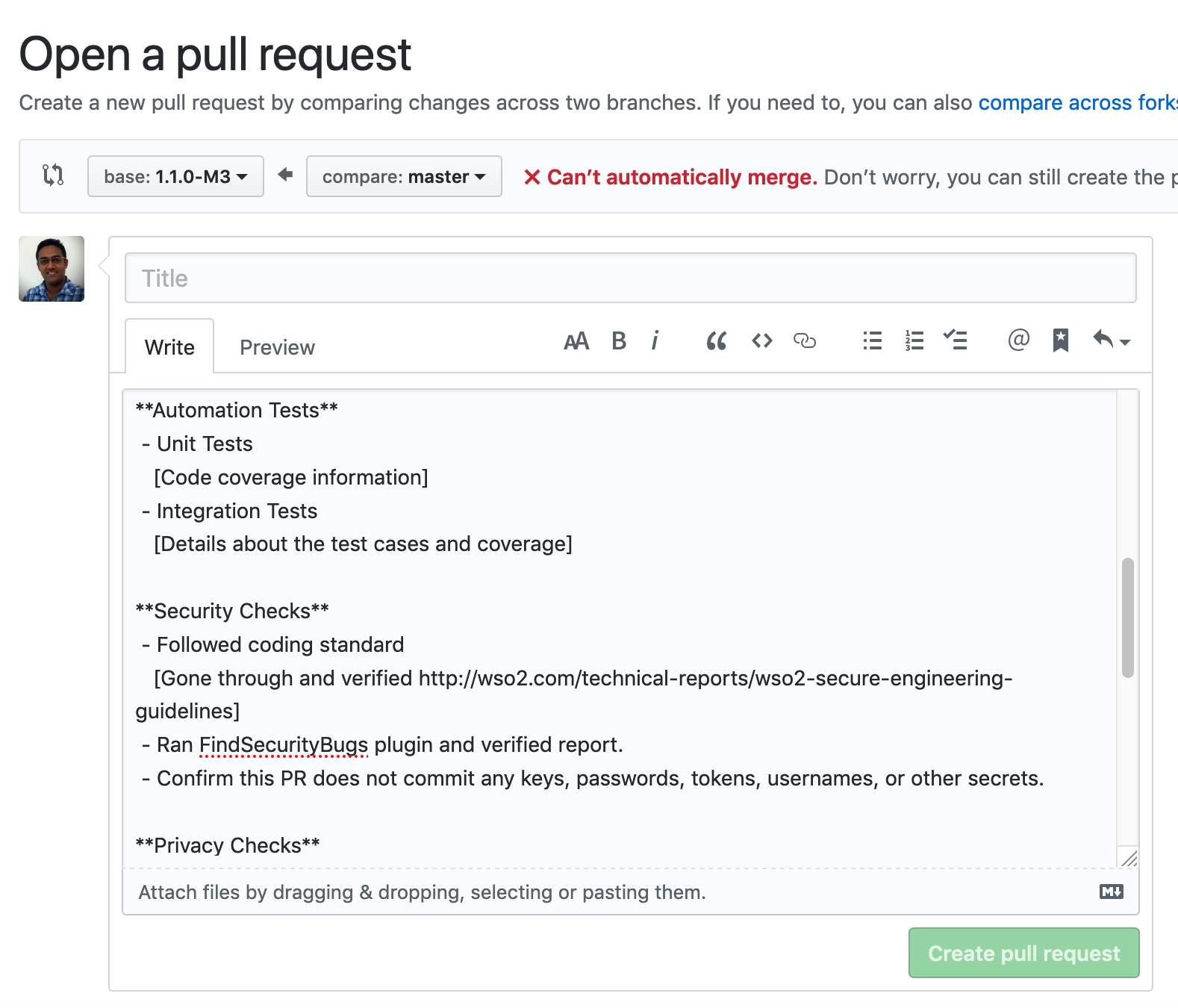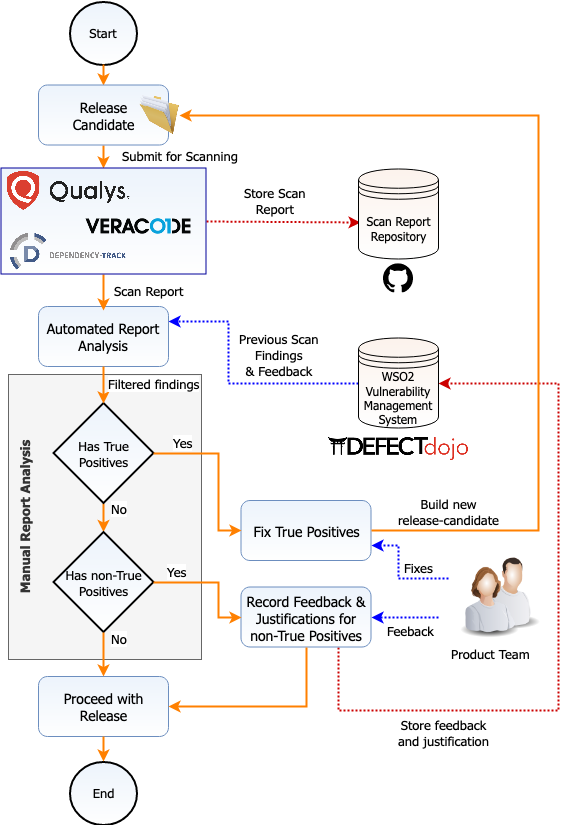Secure Software Development Process (SDLC)¶
Security is not an afterthought at WSO2. It's an integral part of each phase in the development life cycle. This makes sure security vulnerabilities are identified and mitigated as early as possible.

WSO2 Secure Engineering Guidelines provide the overall security guidance during the design, development and code review phases. A group of security leads review designs of new features and also review the code to make sure that engineers are adhering to the guidelines set forth. Some security checks are further enforced when engineers commit the code to the WSO2-maintained code repositories.
Furthermore, before a product release, there are mandatory security scans that look at the security aspect of the release candidate from different perspectives. All the security findings are securely stored in a centralized system for future reference.
This document further explains, each individual phase of this overall process, carried out in order to produce secure software.
Design Phase¶
New feature developments and modifications to the existing features must go through thorough design reviews that evaluate the security aspects of the corresponding component.
The software architects and security leads of the respective product domains must attend to these reviews. Following are some questions that are taken into consideration during these reviews:
- What are the interactions with other components in the system and how do those interactions happen?
- What are the access and trust boundaries of the component?
- Who should be able to consume the functionalities exposed by the component?
- What level of authentication and authorization is required by the component, and what is the granularity of the permissions?
- What are the session management-related requirements? For example, is the forgot password option required?
- Are there configuration elements that include confidential data? If so, how should they be protected?
- Are there confidential data stored in the database? If so, how should they be protected?
- Is the strength of cryptographic keys and algorithms to be used on par with the latest best practices?
- Does an adequate amount of information being logged to understand a security-related incident?
Development Phase¶
Developer Self-review¶
Before any code review, all the engineers must do a self-code review. During development tasks and also during the self-code reviews, it is essential to follow the guidelines set forth by WSO2 Secure Engineering Guidelines.
The Find Security Bugs SpotBugs plugin is recommended to be used in development environments.
Before sending any GitHub Pull Requests (PR), developers must confirm the following workflow:
Developer workflow before creating a pull request

Relevant checks are further enforced by the GitHub PR template:

Code Reviews¶
Each new component must go through a set of code reviews. The participation of one or more security leads is a must for each code review. Once a code review is done, all the findings related to the security aspects must be resolved before merging the component into the code base.
WSO2 Secure Engineering Guidelines should be followed when reviewing the security aspect of the code.
During a code review, two types of vulnerabilities are taken into consideration:
- Exploitable vulnerabilities
- Security weaknesses/defence in-depth issues
The exploitable vulnerabilities have a direct impact and provide an attacker more privileges than allowed. The second type is not directly exploitable and can be used in conjunction with exploitable vulnerabilities to aggravate the impact of an attack. The following lists some of the most common vulnerabilities introduced due to bad coding practices.
- Cross-Site Scripting (XSS) attack
- Cross-Site Request Forgery (CSRF)
- HTTP Response Splitting (Header Injection)
- SQL Injection
During these reviews, the following questions are taken into consideration:
- Are all the entry points and trust boundaries identified by the design?
- Is input validation being applied whenever input is received from outside the current trust boundary?
- Has all input validation been applied in an allow listing fashion which includes data types, formats, and minimum/maximum lengths?
- Does the application perform canonicalization of data prior to validating the inputs?
- Does the application apply defence in depth to the input validation strategy?
- Are all XML inputs validated against an agreed schema?
- Does an appropriate type of encoding apply to an output that includes externally supplied input?
- Do we log any confidential data?
- Do we encrypt or allow encrypting any of the confidential data before being stored?
- Can we encrypt any confidential data read from configuration files?
- PreparedStatement is properly used whenever writing to or reading from a database.
- Does the application store passwords and other confidential data in the format of
char[]instead ofString? - Do the default values carry the most secure option?
Release Process¶
A release candidate goes through three types of security checks to make sure that the product is in a secure state.
Static Code Analysis¶
Static Code Analysis is used to identify possible vulnerabilities within source code by using techniques such as Taint Analysis and Data Flow Analysis.
Apart from the Find Security Bugs Spotbugs plugin which is used in the development phase, WSO2 uses the Veracode commercial static analyzer for this purpose.
WSO2 uses the Trivy, Open-source image scanner for finding OS level vulnerabilities in WSO2 docker images.
Note
The security issues relevant to the third-party dependencies are covered separately with the Third-Party Dependency Analysis effort. Therefore, the source code of the third-party dependencies is excluded from the static code analysis.
Dynamic Analysis¶
Dynamic Analysis is used to search for software vulnerabilities when the code is in operation mode. The analysis is performed when the application is running.
WSO2 uses Qualys Web Application Scanner (Qualys WAS) for dynamic security scanning.
Third-Party Dependency Analysis¶
Security vulnerabilities identified in third-party dependencies may affect the security of the product. WSO2 prevent such security impacts that could occur due to third-party dependencies at a few stages.
It is essential to prevent the introduction of new third-party dependencies with known security vulnerabilities. Therefore, with any third-party dependency approval request it is essential to attach the OWASP Dependency Check report, adhering to the Introducing New External Dependencies section of the WSO2 Secure Coding Guidelines.
New security vulnerabilities related to third-party dependencies may get identified and fixed at any given time. Therefore, continuously monitor different sources to identify if a new vulnerability has been identified or fixed.
WSO2 uses the OWASP Dependency Track for this purpose with product versions released after Q1 2020. The National Vulnerability Database (NVD) is queried for third-party dependency issues and alerts will be generated if a new issue has been identified. It is required to update the dependency or add a mitigation comment explaining why the relevant vulnerability does not apply to the product.
Mandatory checks during releases¶

To request a security scan (Veracode, Qualys or Dependency Track), product teams create an issue in the internal security GitHub project, attach the related product pack, and send an email notification to security-leads-group@wso2.com, with a reference to the corresponding GitHub issue.
Even though security scans can be scheduled at any time, based on the requests from the product teams, it is mandatory to perform all three scan types (static scan, dynamic scan, third-party dependency scan) before a product release. This involves the following:
- Get the version to be released and scanned using the scanner
- Prepare a feedback report for any false positive, not a threat, not applicable or already mitigated findings. The feedback should include:
- Comment on why the issue is categorized as such
- Details about the use case of the relevant logic
- Details about the impact of the reported issue
- Fix all true positive issues identified
- Rescan the product before the release vote, if complex changes have occurred between the initial security scan and the actual release vote, preventing manual verification of security fixes.
If any of the aforementioned items are not complete, Platform Security Team will down vote the release, preventing the product from getting released.
Vulnerability Management¶
All issues reported by static code analyzers, dynamic scanners and dependency scans will be uploaded into a centralized Vulnerability Management System (VMS). WSO2 uses OWASP Defect Dojo as the centralized VMS.
This centralized VMS can be used to identify duplicates in future reports and also to automatically provide feedback for security scan reports sent by WSO2 customers, largely reducing the manual effort required in analyzing security reports.